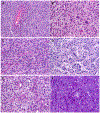Recurrent YAP1-TFE3 Gene Fusions in Clear Cell Stromal Tumor of the Lung
- PMID: 33899786
- PMCID: PMC8516668
- DOI: 10.1097/PAS.0000000000001719
Recurrent YAP1-TFE3 Gene Fusions in Clear Cell Stromal Tumor of the Lung
Abstract
Clear cell (hemangioblastoma-like) stromal tumor of the lung (CCST-L) is a recently described distinctive rare pulmonary neoplasm of unknown histogenesis and molecular pathogenesis. Only 7 cases have been reported in 2 recent studies, although additional cases might have been reported under the heading of extraneural pulmonary hemangioblastoma. We herein describe 4 CCST-L cases, 3 of them harboring a YAP1-TFE3 fusion. The fusion-positive tumors occurred in 3 women, aged 29, 56, and 69 years. All presented with solitary lung nodules measuring 2.3 to 9.5 cm. Histologically, all tumors showed similar features being composed of relatively uniform medium-sized epithelioid to ovoid cells with clear cytoplasm and small round monomorphic nuclei. Scattered larger cells with enlarged hyperchromatic nuclei and marked pleomorphism were noted in 2 cases. The tumors were associated with a hypervascularized stroma with variable but essentially subtle resemblance to capillary hemangioblastoma and perivascular epithelioid cell tumor (PEComa). Immunohistochemistry was negative for all lineage-specific markers. Targeted RNA sequencing showed a YAP1-TFE3 fusion in 3 of 4 cases. All 3 tumors showed homogeneous nuclear TFE3 immunoreactivity. Two patients were disease free at 36 and 12 months. The third patient had biopsy-proven synchronous renal and hepatic metastases, but extended follow-up is not available (recent case). The fourth case lacking the fusion affected a 66-year-old woman and showed subtle histologic differences from the fusion-positive cases, but had comparable TFE3 immunoreactivity. CCST-L represents a distinctive entity unrelated to hemangioblastoma and likely driven by recurrent YAP1-TFE3 fusions in most cases. The relationship of our cases to the recently reported "hemangioblastoma-like" CCST-L remains to be determined. Analysis of larger series is paramount to delineate the morphologic spectrum and biological behavior of this poorly characterized entity.
Copyright © 2021 Wolters Kluwer Health, Inc. All rights reserved.
Conflict of interest statement
Conflicts of Interest and Source of Funding: Supported in part by: P50 CA217694 (C.R.A.), P50 CA140146 (C.R.A.), P30 CA008748 (C.R.A.), Cycle for Survival (C.R.A.). The authors have disclosed that they have no significant relationships with, or financial interest in, any commercial companies pertaining to this article.
Figures







Similar articles
-
YAP1::TFE3 fusion in a case of malignant TFE3-rearranged PEComa of the lung: expanding the spectrum of pulmonary PEComa-like mesenchymal neoplasms.Virchows Arch. 2025 Mar;486(3):621-626. doi: 10.1007/s00428-024-04016-y. Epub 2025 Jan 3. Virchows Arch. 2025. PMID: 39751663
-
Inflammatory spindle cell PEComa of the lung with YAP1::TFE3 fusion: a report of two cases and a potential relationship with clear cell stromal tumour.Histopathology. 2025 Feb;86(3):365-372. doi: 10.1111/his.15328. Epub 2024 Sep 26. Histopathology. 2025. PMID: 39327855
-
Clear cell stromal tumour of the lung with YAP1::TFE3 fusion: four cases including a case with highly aggressive clinical course.Histopathology. 2022 Aug;81(2):239-245. doi: 10.1111/his.14706. Epub 2022 Jul 11. Histopathology. 2022. PMID: 35762906
-
Ocular PEComas are frequently melanotic and TFE3-translocated: report of two cases including the first description of PRCC-TFE3 fusion in PEComa.Virchows Arch. 2021 May;478(5):1025-1031. doi: 10.1007/s00428-020-02890-w. Epub 2020 Jul 16. Virchows Arch. 2021. PMID: 32676967 Review.
-
PHF1::TFE3-positive fibromyxoid sarcoma? Report of 2 cases and review of 13 cases of PHF1::TFE3-positive ossifying fibromyxoid tumor in the literature.Am J Clin Pathol. 2025 Feb 12;163(2):224-230. doi: 10.1093/ajcp/aqae114. Am J Clin Pathol. 2025. PMID: 39250713 Review.
Cited by
-
Case Report: Hemangioblastoma- Like Clear Cell Stromal Tumor of the Left Lower Lung.Front Med (Lausanne). 2022 Apr 18;9:836012. doi: 10.3389/fmed.2022.836012. eCollection 2022. Front Med (Lausanne). 2022. PMID: 35510252 Free PMC article.
-
YAP1::TFE3 fusion in a case of malignant TFE3-rearranged PEComa of the lung: expanding the spectrum of pulmonary PEComa-like mesenchymal neoplasms.Virchows Arch. 2025 Mar;486(3):621-626. doi: 10.1007/s00428-024-04016-y. Epub 2025 Jan 3. Virchows Arch. 2025. PMID: 39751663
-
Perivascular Epithelioid Cell Tumor of the Lung With a Novel YAP1::TFE3 Fusion.Int J Surg Pathol. 2025 Sep;33(6):1519-1525. doi: 10.1177/10668969251323936. Epub 2025 Mar 13. Int J Surg Pathol. 2025. PMID: 40080865 Free PMC article.
-
Clear cell stromal tumor of the lung with multinucleated giant cells: a report of a case with YAP1-TFE3 fusion.Diagn Pathol. 2023 Jan 27;18(1):9. doi: 10.1186/s13000-023-01304-0. Diagn Pathol. 2023. PMID: 36707859 Free PMC article.
-
Non-small cell lung carcinoma with clear cell features: a clinicopathologic, immunohistochemical, and molecular study of 31 cases.Virchows Arch. 2024 Jul;485(1):83-96. doi: 10.1007/s00428-024-03833-5. Epub 2024 May 30. Virchows Arch. 2024. PMID: 38814477
References
-
- Bisceglia M, Muscarella LA, Galliani CA, Zidar N, Ben-Dor D, Pasquinelli G, la Torre A, Sparaneo A, Fanburg-Smith JC, Lamovec J, Michal M, Bacchi CE. Extraneuraxial Hemangioblastoma: Clinicopathologic Features and Review of the Literature. Adv Anat Pathol. 2018;25:197–215. - PubMed
-
- Michal M, Vanecek T, Sima R, et al. Primary capillary hemangioblastoma of peripheral soft tissues. Am J Surg Pathol. 2004;28:962–966. - PubMed
-
- Doyle LA, Fletcher CD. Peripheral hemangioblastoma: clinicopathologic characterization in a series of 22 cases. Am J Surg Pathol 2014;38:119–27. - PubMed
-
- Lindholm KE, Moran CA. Hemangioblastoma-like Clear Cell Stromal Tumor of the Lung: A Clinicopathologic and Immunohistochemical Study of 5 Cases. Am J Surg Pathol. 2020;44:771–775. - PubMed
Publication types
MeSH terms
Substances
Grants and funding
LinkOut - more resources
Full Text Sources
Other Literature Sources
Medical

